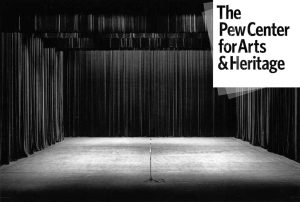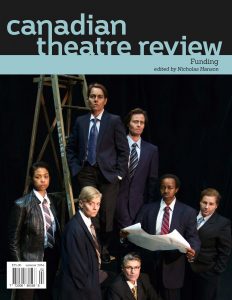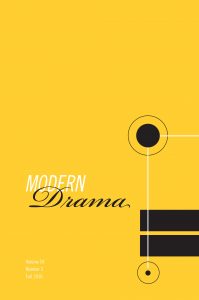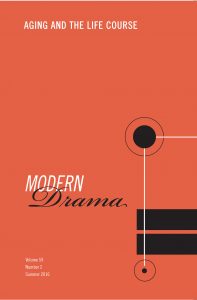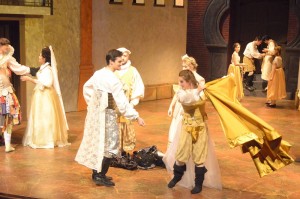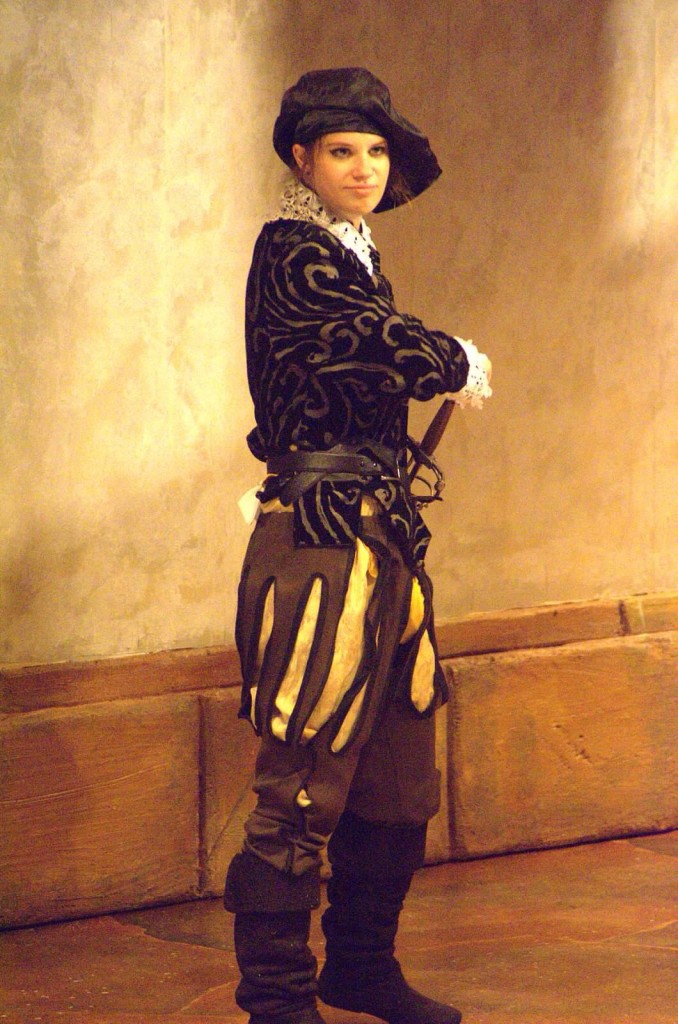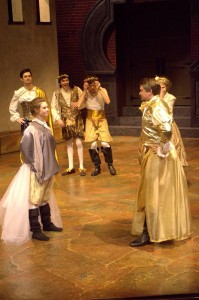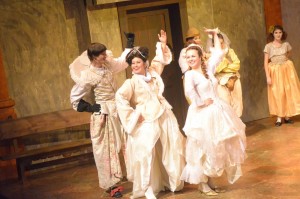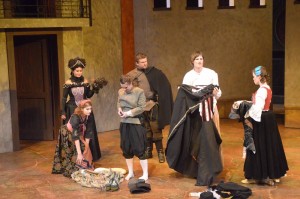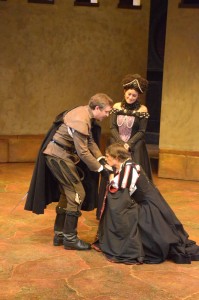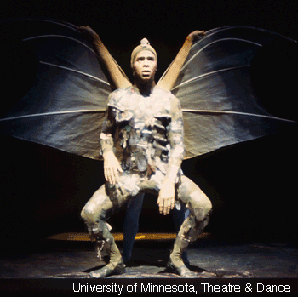We learn of a warp in time-space, one that actually occurred here on Earth, from Gertrude Stein who, in The Autobiography of Alice B. Toklas (1932), reflects on the portrait of her painted by Pablo Picasso. It was some time around 1905-1906, Picasso was between periods and thus experimenting with different visions. He had never done a portrait, a fact that might explain why he required ninety sittings from Stein in order to complete it. So much work went into it, so much thought. Upon its unveiling, however, commentators pointed out that the portrait lacked the one element so crucial to the genre. It didn’t look like her. Or, rather, Stein didn’t look like it. Either way, Stein’s representation in oil didn’t represented Stein in the flesh didn’t represent Stein in oil. To this, Picasso famously replied, “She will,” meaning that at some point in the future, Stein would live up to the representation. And sure enough, as time passed, Stein seemingly lived into her artistic representation, growing in appearance more and more like her painting, thereby revealing Picasso’s ability to chart matter’s unfolding through time and space as well as how an art object can act as a foreshock to the future.[1]
As a theatre and performance scholar struggling to make sense of the recent turbulence of the election, I have been asking myself: Is there an analogue in theatre history to this event of painting, one that prefigures our recent election cycle and outcome and acts similarly as a foreshock to the future in which we now dwell? Simon Critchley’s recent post in The Stone about the renewed importance of Existentialist nausea goads my thought, too, though I would like to emphasize here not a philosophical paradigm as such but rather a theatrical-philosophical one.
The foreshock that first comes to mind is The Chairs (1952) by Eugène Ionesco. In this play, now a canonical title belonging to what Martin Esslin named Theatre of the Absurd, we find two characters of greatly advanced age struggling, in essence, to make their lives great again. Dialogue, if we can call it that, drenched in memories, perhaps misremembered recollections, oscillates from semi-sensical to nonsensical and back again, slowly rendering a fuzzy image of the two characters’ present situation. The Old Man, we discover, has something of major import to tell us. He has worked his whole life to express this majorly important insight about the world in which he lives, but he does not have the language to do it. To get the message across, the Old Man has enlisted the help of an Orator who, the Old Man assures us, will convey the full thrust of The Message.
In anticipation and celebration of the Orator’s address, the old couple throws a party. As the play progresses, Ionesco gradually ratchets-up an odd feeling of dis-ease and eventually reveals to the play’s audience that each party guest, while bearing a name and a clear social function, is invisible. One by one, the old couple welcomes these invisible people into their living space. A separate chair marks each guest. It is unclear whether they, the characters, can see these invisible entities or whether they are engaged in some kind of willing suspension of disbelief themselves, a kind of selective dementia. Regardless of the true ontic status of these invisible characters, the frenzy of anticipation grows until the play almost combusts in a conflagration of fragmented speech and hurried movement. The stage, once empty, fills with chairs. The Old Man and Old Woman are moving so quickly that we have either to doubt their age—listed as 95 and 94 in the text—or accept that the vitality of the moment has enthused them.
The Orator finally arrives, and after a suitably grand introduction delivers The Message. But, once again, Ionesco constructs the logic of this moment with his signature strangeness. The Orator speaks in discernable sounds, but not in familiar speech. We learn in the text that he is a “deaf mute,” and thus his message, the oh-so important message hyped throughout the play, is incommunicable and unintelligible. Even when the Orator determines to write The Message on a blackboard, thereby overcoming the problem of the spoken word, the audience, both on and off stage, receives the following: ANGELFOOD […] NNAA NNM NWNWNW V. And so The Message does not land, it cannot land since it seems to have no content. Yet, with renewed vigor, the Orator erases the board and seems to conceive of a remedy: ∧ADIEU ∧DIEU ∧P∧. There’s The Message all worked out. Can’t you see it?
Can we not imagine Trump, Clinton, or Sanders as the contemporary embodiment of the Orator? Enlisted to put into words the message of many disgruntled and uncomfortable citizens of the United States, the message we eventually receive from them is in fact a string of sounds and symbols that have no real import beyond the readymade intelligibility that each sound and symbol may carry for acolytes and those initiated in each politician’s way. As with the Orator’s message, we might ask whether the messages of these politicians lack sense intrinsically or whether some of us lack the reservoir of knowledge to understand the all-important utterance? That Trump won means only that there were more members of the Electoral College who seemed to understand his ∧ADIEU ∧DIEU ∧P∧.
In The Chairs, once the confusion of the message begins to register with the audience—Like, oh, this is it? This is what we’ve been waiting for?—we in the house seats start to re-appraise the character of the Orator. Is he a normal character? Is not something a little bit off about him? Is he indeed a deaf mute (as the text suggests), or is he playing one, perhaps even mocking one? Have we perhaps, because of his title of Orator, overlooked something beneath his appearance? The fact of the matter is that we do not have, nor will we ever receive, answers to these questions. Ionesco, in his stage directions, tells us that the Orator seems displeased with the way his message has landed, but the audio track that slowly rises onstage—“bursts of laughter, murmurs, shh’s, ironical coughs”—suggests that some of the invisible people have understood something. Maybe the Orator’s appearance of displeasure is something else altogether, a kind of body language decipherable only to those who speak his language. After all, before he exits the stage he “bows ceremoniously,” as if he has done what he was summoned to do. When the play ends, a lot has just happened, but what precisely are we to make of any of it?
Back to the present day similarities: The Old Couple foreshadows the electorate. Old and young at the same time, they are equipped with vivid memories but also ample disillusionment, i.e., memories of a past that never existed, able to recognize the meaning of life, the universe, and everything, but simply unable to speak it for themselves. Due to this inability, they require a spokesperson, a surrogate, a representative to drive the message home in precisely the right terms, i.e., terms that make sense to them.
Even the scenography of the piece, which Ionesco draws out in great detail on the first few pages of the script, eerily resembles the floor of a Parliament or legislature: a semi-circular configuration of chairs facing a raised dais with a discernible left side and right side. Are the characters of the play gathered in a political arena that has been evacuated of its use and now functions as a party venue?
While not a completely verisimilar replica of the current political situation, The Chairs nonetheless predicts the confusion, the miscommunication, the enthusiasm paired with despair, and the general out-of-tune-ness of the state in which many now find themselves. A message has been delivered, but can anybody say what precisely that message is. ∧ADIEU ∧DIEU ∧P∧, indeed.
Looking back to the precursors of Ionesco’s brand of theatre, I find another intriguing foreshock: Luigi Pirandello’s Six Characters in Search of an Author (1921). Midway through that play’s action, which itself consists of a rehearsal of a play preparing for its grand opening, the doors in the back of the auditorium open. Through the very same doors through which the audience will have entered comes an ensemble of characters that, so we are told, are searching for their author. At this moment, “real-life” audience and “fictional” stage actors are united in an uncanny experience that hinges on a seemingly impossible reversal of cause and effect: before an author has created them, a cast of characters wanders the earth. Struggling with this twist of temporality, the six characters plead with the actors to put their story into action.
All of this happens within the framework of a play-within-a-play, what Lionel Abel eventually terms metatheatre. The result of this upon the “real” audience watching the play was profound in its day. Audience members shouted in disbelief: Manicomio! (Madhouse!) Incommensurabile! (Incommensurable!).[2] The uncommon event transpiring within the theatre eventually ends tragically, due in part to an inability between the actors and the six characters to determine the precise mode of realism needed to bring the characters to life, in part to the fact that causality has been broken, and in part to the actors’ inability to properly author the ciphers who appeared before them. The characters are indeed ciphers, placeholders with relatively common dimensions—denoted by names such as “Father” and “Daughter”—waiting to be filled out, but the filling out does not transpire properly and thus tragedy befalls the lot of them. Many of the six characters “die” at the end, but the Director of the “real” show is unsure whether it matters. After all, they weren’t real people were they?
In this foreshock, our recent presidential hopefuls corresponded to Pirandello’s characters. We, the electorate, are going about the dramas of our daily lives when there appears a group of characters claiming to need our support in order to bring their visions to fruition. Clinton is the archetypal matriarch, Trump the dominating and witheringly masculine patriarch, Sanders the son (who, in Pirandello’s play hates the family because they have ostracized him). We, the electorate, are told that without us the power of these characters cannot come into being. We are needed to author the promise of each character. Without us, these characters are empty placeholders, Zeroes, but when we do our best to play our parts we find that the joke is on (half of) us. We act through our vote only to discover that the majority of the voting population hasn’t accomplished anything real at all. The votes counted and didn’t count in the end. Were they fictional votes? Does it really matter?
The point I’d like to make here with these strange resonances between absurdist plays and our recent election cycle is this: history is not repeating itself as either tragedy or farce; it is, rather, fulfilling its identity as the theatre of the absurd. Therefore, the present reality is not absurd in its own right, but is instead theatre of the absurd. We are experiencing another stage in the evolution of the Theatre of the World. Maybe this is the most important aspect of Absurdism that scholars like Esslin have overlooked; namely, that, despite its clear relationship to the climate of the times (post-WWII), the theatre of Ionesco and his contemporaries actually conjured a vision of a future, a future that has revealed itself to be the present in which we live. We have, in other words, finally grown into the misery of the world portended by the Absurdists over half-a-century ago.
Faced with this possibility, what we need today is a team of theatre and performance scholars to investigate this current theatre in which we all find ourselves. To do this, the team could break down the theatre into its constituent parts. For example: language. Is it too much of an exaggeration to say that an orangutan testing the depths of a pool blocking its path is more adept with its tool than any of the presidential contenders were with the tool of language?[3] Transcripts from stump speeches prove clearly that not only did language fail to communicate specific messages to the gathered audiences but also that language consistently failed to rise to the level of meaning at all.
Of course, Trump’s are the most amenable to my argument, as this excerpt from a rally in South Carolina on July 21, 2015, proves:
Look, having nuclear — my uncle was a great professor and scientist and engineer, Dr. John Trump at MIT; good genes, very good genes, okay, very smart, the Wharton School of Finance, very good, very smart — you know, if you’re a conservative Republican, if I were a liberal, if, like, okay, if I ran as a liberal Democrat, they would say I’m one of the smartest people anywhere in the world — it’s true! — but when you’re a conservative Republican they try — oh, do they do a number — that’s why I always start off: Went to Wharton, was a good student, went there, went there, did this, built a fortune — you know I have to give my like credentials all the time, because we’re a little disadvantaged — but you look at the nuclear deal, the thing that really bothers me — it would have been so easy, and it’s not as important as these lives are […][4]
Where Clinton’s language is concerned, the problem is not outright grammar-less nonsense but, rather, vagueness and empty talk. In her speech for the acceptance of the Democratic Party’s nomination, for example, we heard, “Now we are clear-eyed about what our country is up against. But we are not afraid. We will rise to the challenge, just as we always have.” And then we heard about building a road to citizenship (how?), fixing inequality and social mobility (in what way?), creating better jobs (in what fields?), that climate change is real (…duh?), and other broad-sweeping claims that people in the room with her already believed. What, though, was the main message of her campaign? There wasn’t one. There wasn’t one, and so her speeches could at best aim not to set an agenda but, rather, to accomplish everything that liberals want and to do it all well. This vagueness and lack of message may in fact explain why Clinton polled at 47% for nearly the entirety of her campaign. No message = no change in polls because there’s no new information into which swing voters might tune. (I’d need another 4000 words to discuss the language and logic of polls.)
As was the case in the plays of Ionesco, language did not function in the campaign as a tool to convey meaning but, rather, as a tool to produce not-fully-understood affective responses. With the dog-whistle politics of Trump and the vapid sloganeering of Clinton’s talk, the electorate was left with sound and fury, nothing more. The candidates stripped language down to basic sounds with indeterminate meaning and a hint of recognizable vitriol. In terms of reception, the negatively polarized electorate heard only what it already believed to be true. Like high school fans catching the Fab 4 in concert during the height of Beatlemania, whose screaming drowned out the sound and lyrics of the musicians, the role of the polarized electorate was never to listen to speeches and be convinced of something new. No, the role allowed individuals to cheer and believe that their candidate was saying what they believe he/she has said in the past and what they already fervently believed in before the election cycle even started. Such a breakdown in language’s traditional function as meaning-maker, communication facilitator, or, God forbid, medium of reason, means that we have no hope of applying Aristotle’s tried and true ethos, pathos, logos analytical scheme to the campaign rhetoric. Trump: all pathos (fear), no ethos, no logos. Clinton: all logos (neoliberal), no pathos, no ethos. When we look back on all the transcripts and search for meaning in the words, do we really find anything more “meaningful” than the words uttered by the Old Man and Old Woman in The Chairs?
George Saunders was well aware of this problem when it sprouted a particularly pungent blossom several years ago in the form of Sarah Palin. His essay for the New Yorker, “My Gal” plays with this new de-tooled language. Here are the first two paragraphs in case you missed it:
Explaining how she felt when John McCain offered her the Vice-Presidential spot, my Vice-Presidential candidate, Governor Sarah Palin, said something very profound: “I answered him ‘Yes’ because I have the confidence in that readiness and knowing that you can’t blink, you have to be wired in a way of being so committed to the mission, the mission that we’re on, reform of this country and victory in the war, you can’t blink. So I didn’t blink then even when asked to run as his running mate.”
Isn’t that so true? I know that many times, in my life, while living it, someone would come up and, because of I had good readiness, in terms of how I was wired, when they asked that—whatever they asked—I would just not blink, because, knowing that, if I did blink, or even wink, that is weakness, therefore you can’t, you just don’t. You could, but no—you aren’t.
Saunders went wild over the fact that the key of each Palin sentence, that which was supposed to unlock the hermetic meaning in each convoluted expression, was never tendered. And this way of speaking (strategy?) was somewhat brilliant because it compelled listeners to keep listening for the moment when the idea landed. But it never landed.
If we can compare Palin’s wandering talk with Trump’s nonsense, then we can also compare the empty sloganeering of the McCain/Palin ticket with that of the Clinton/Kaine ticket. Saunders also helps us here as he walks through the 2008 Republican banner slogan:
Now, let’s talk about slogans. Ours is: Country First. Think about it. When you think of what should come first, what does? Us ourselves? No. That would be selfish. Our personal families? Selfish. God? God is good, I love Him, but, as our slogan suggests, no, sorry, God, You are not First. No, you don’t, Lord! How about: the common good of all mankind! Is that First? Don’t make me laugh with your weak blinking! No! Mercy is not First and wisdom is not First and love is super but way near the back, and ditto with patience and discernment and compassion and all that happy crap, they are all back behind Country, in the back of my S.U.V. […]
Given his interest/fear in the unmooring of language in 2008, it is no surprise that Saunders turned up again in the eye of the Trump storm, this time not to accost through wit but to understand who exactly these Trump supporters are. He attended Trump rallies, admitting to those he met that he himself was once an avid reader of Ayn Rand and a registered Republican who voted for Reagan. Bonding in this way seemed to give him access to interviews with the Trump supporters gathered there, such as this woman:
I ask her what, in terms of her day-to-day life, she thinks is wrong with America.
“I don’t like people shoving Obamacare down my throat, O.K.?” she says. “And then getting penalized if I don’t have insurance.”
Is she covered through Obamacare?
No. She has insurance through her work, thank God, but “every day my rights are being taken away from me, you know?” she says. “I mean—this is America. In the U.S., we have a lot of freedoms and things like that, but we’re not going to have all that if we have all these people coming in, that are taking our—”
What is on display here if not the same antilogic (illogic? ill-logic?) that subtends the ever-weakening rationality of the masses in Ionesco’s Rhinoceros (1959)? In that play, Ionesco weaves a discussion between the Logician and the Old Gentleman about syllogisms that functions something like background music to the primary dialogue unfolding between the play’s lead characters:
Logician: [to the Old Gentleman] Here is an example of a syllogism. The cat has four paws. Isidore and Fricot both have four paws. Therefore Isidore and Fricot are cats.
Old Gentleman: [to the Logician] My dog has got four paws.
Logician: [to the Old Gentleman] Then it’s a cat.
[…]
Old Gentleman: [to the Logician, after deep reflection] So then logically speaking, my dog must be a cat?
Logician: [to the Old Gentleman] Logically, yes. But the contrary is also true.
This lesson builds to a more complex example of two cats and the number of their paws. Instigated by the Logician’s question, “If you take six paws from the two cats, how many paws are left to each cat?” the Old Gentleman delivers a wide range of answers before stumbling into the category of the unnatural: one cat with five paws, a cat with one paw, a cat with six paws or with no paws at all—all logically possible. These possibilities lead to further possibilities of some cats with special privileges (those with paws) and some cats without privileges (those with no paws). Here the Logician fuses the path of Logic with that of Justice and declares: “Logic means Justice.” But Ionesco undercuts this statement with the sound of a rhinoceros, thereby suggesting that some bestial thinking undergirds the logician’s seemingly scientific rationality. Saunders seems to have discovered a similar (il)logicality in the thinking of Trump supporters, one that aligns with their (in)justice. Violence lurks beneath this irrational rationality.
So we find ourselves now, after the election, cast within the theatre of the absurd. If language has acquired an Ionesco-like ambivalence and malleability, one of our jobs moving forward must be to understand how this theatrical language works, how it is put to use, and what worlds it is capable of making. But theatre and performance scholars should also rush in to assess other constituent parts of this theater: the embodied knowledge of protesters, for example, and the scenography of violent police shootings, and the mis en scène set by those who claim to be directors of the national interest. In short, what we need now is a dramaturgy of this theatre of the absurd, perhaps one armed with a solid background in Wittgenstein and the notion of language games.
Another foreshock, the last I’ll mention, occurred prior to my writing of this essay. Two days before the election I randomly pulled F. Scott Fitzgerald’s “Crack Up” off my bookshelf. In that story, the narrator (who seems to be a surrogate of Fitzgerald himself) tells us that the mark of true intelligence is the ability to hold two opposed ideas in one’s head. For example, and to stay in the key of the Absurdists, that I can’t possibly go on and I must go on. The narrator who says this with such certainty, however, also vouchsafes to his reader the fact that he himself is slowly going crazy, slowly cracking up. To practice true intelligence is to risk insanity. The primary opposition in the story, the one that will fuse disjunctively into a profound realization of self and world, comes from the confrontation between the narrator and the narrator’s wife (who resembles Zelda). During a bitter argument, the former explains his belief that his crack is interior to himself and thus he himself bears the responsibility of fixing it (or ignoring it altogether with alcohol), while the latter works from the opposite belief that the crack is outside. “The crack is in the Grand Canyon!” she yells. The story ends abruptly, without resolve, and so leave us with questions. Are we to follow the internal crack-up into our own individual depths, thereby pushing our sanity to the brink no matter how dangerous that may be, or do the cracks of the natural and social words impinge on our sanity to such a degree that our job is to map those forces and explore them like an intrepid scout?
With so many cracks showing now in the aftermath of the election, which path are we to follow? “Of course all life is a process of breaking down,” Fitzgerald tells us, and so we see the cracking of language all around us. But the inevitability of breaking down, either through internal cracks or by external blows, does not preclude an attitude of good humor and sharp wit. Indeed, it is precisely now, with the help of our life dramaturgs, that we may find a new dimension to language altogether, one that frees us from the paradigms of right/left, black/white, 99%/1%, and produces instead a new cosmology.
[1] http://www.metmuseum.org/toah/works-of-art/47.106/
[2] https://www.wikiwand.com/en/Six_Characters_in_Search_of_an_Author
[3] Take your pick: http://ow.ly/AoVf3069nZr
[4] http://www.vox.com/2016/8/18/12423688/donald-trump-speech-style-explained-by-linguists
